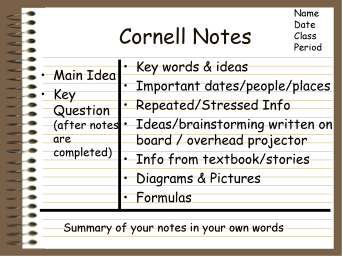In today’s fast-paced academic and professional world, taking effective notes isn’t just a study strategy; it’s a survival skill. Whether you’re a student, a researcher, or a lifelong learner, organizing your thoughts clearly and systematically is the key to understanding and retention. One of the most time-tested and efficient methods for this is the Cornell Notes System.
Originally
developed at Cornell University by education professor Walter Pauk in
the 1950s, this system is still widely used in schools, colleges, and
knowledge-intensive workplaces today.
What is the Cornell Notes System?
The Cornell
Notes System is a note-taking format that structures your notes in a
logical, review-friendly layout. Rather than writing down everything you hear
or read in one continuous stream, Cornell Notes divides the page into three
distinct sections:
1. Cue
Column (Left Side)
Used for questions,
keywords, or prompts. This section helps you engage in active
recall, think critically, and review easily.
2. Note-Taking
Column (Right Side)
This is where
you write the main notes during a lecture, reading, or study session. It
includes key points, definitions, diagrams, and examples.
3. Summary
Section (Bottom)
At the end of
the session, you summarize the entire page in your own words. This reinforces
learning and solidifies understanding.
How to Set Up Cornell Notes
Here’s how to
create a Cornell Notes page on paper or digitally:
Layout
Instructions:
- Draw a vertical line about 2.5 inches from the left
margin (for the Cue Column).
- Leave a bottom space of about 2
inches (for the Summary).
- Use the main right-hand space
for detailed notes.
Here’s a visual
guide:
Step-by-Step: How to Use Cornell Notes
Step 1: Take Notes
During class or
reading, use the right column to write down key ideas in bullet points
or brief phrases. Don’t try to copy everything—focus on the main points.
Step 2: Write Cues
After class,
review your notes and fill in the left column with keywords, questions,
or prompts based on the right-side content. These cues guide your self-testing
later.
Step 3: Summarize
At the bottom
of the page, write a summary (3–5 sentences) of what you learned. This
helps with reflection and memory retention.
Step 4: Recite & Review
Cover the
right-hand notes. Try to answer the questions or recall the points using only
the cues. Then check for accuracy. Repeat regularly for long-term retention.
💡 Why Use the Cornell Notes System?
1. Promotes Active Learning
By forcing you
to summarize and reflect, it transforms passive note-taking into active
engagement.
2. Enhances Memory & Understanding
The spaced
layout aids in organizing information and makes it easier to revisit and
review.
3. Supports Critical Thinking
Writing
questions and cues helps you evaluate, synthesize, and apply what you
learn—beyond rote memorization.
4. Ideal for Exam Prep
Cue-based
review makes Cornell Notes an excellent tool for revision and self-quizzing.
Cornell Notes in Practice: A Sample
|
Cue
(Question/Key Idea) |
Notes
(Main Concepts) |
|
What is
Kairos in writing? |
Kairos refers
to the right timing and context in rhetoric—delivering a message at the most
opportune moment. |
|
What is
Ethos? |
Ethos appeals
to credibility. Writers use it to establish authority and trust. |
|
How to
paraphrase? |
Expressing
the same idea using your own words and sentence structure, while retaining
meaning. |
✍️ Summary:
Cornell Notes
help me capture rhetorical concepts clearly and revise efficiently. The
structure forces me to reflect and retain core ideas beyond the surface.
Tools to Use Cornell Notes Digitally
You can easily
apply the Cornell format using:
- Notion
- OneNote
- Evernote
- Google Docs
- Handwritten notebooks or printable

